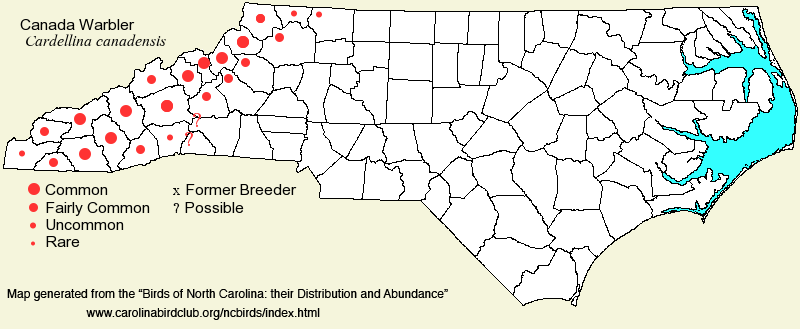 |  |
|
Canada Warbler - Cardellina canadensis PARULIDAE Members: | Search Common: Search Scientific: |
|
|
|||||||
| General Comments | As with most warblers, in 2011 the Canada Warbler was moved from one genus to another -- this time, from Wilsonia to Cardellina. It is fairly well-named, as it breeds mainly in the southern part of Canada, southward through the Appalachians. The species is an inhabitant of dense shrubs and low understory, inside cool forests. In North Carolina, breeding habitat almost always has a very dense rhododendron layer, and at times Mountain Laurel, beneath a varied canopy. It occurs in spruce-fir, spruce-hardwood, and even pure hardwood forests; formerly, hemlock forests were important (prior to the death of most hemlocks). The sites are usually somewhat moist, but they are always rather dark and cool. The species passes through the rest of the state in migration, normally found in deciduous shrubs or understory trees inside hardwood or mixed forests; again, the denser the cover, the better for the warbler. | ||||||
| Breeding Status | Breeder | ||||||
| NC BRC List | Definitive | ||||||
| State Status | |||||||
| U.S. Status | |||||||
| State Rank | S4B | ||||||
| Global Rank | G5 | ||||||
| Coastal Plain | Transient. In spring, rare along the western edge of the region, but farther eastward is very rare to casual, except very rare close to the coast. In fall, rare throughout the region. Mainly early to late May, and late Aug to early Oct. Peak counts: 4, Dismal Swamp SP, Camden, 18 May 1994. | ||||||
| Piedmont | Transient. Rare to uncommon in both spring and fall across the region. Not obviously more numerous in fall than in spring. Mainly early to mid-May, and late Aug to late Sep. Peak counts: 3, on several occasions. | ||||||
| Mountains | Summer resident, with migratory movements. Fairly common to common in summer at the higher elevations, from the mountain summits down to about 3,500 feet; rare and local to about 3,000 feet. Elsewhere, an uncommon migrant at the lower elevations. Mainly late Apr to late Sep. Peak counts: | ||||||
| Finding Tips |
Easy to find at higher elevations in summer. Though it occurs in dense shrubs and understory, it is somewhat inquisitive and often responds to squeaking. **** | ||||||
| Attribution | LeGrand[2023-04-10], LeGrand[2012-10-03], LeGrand[2011-12-18] | ||||||
| NC Map Map depicts all counties with a report (transient or resident) for the species. | Click on county for list of all known species. |
| NC Breeding Season Map Map depicts assumed breeding season abundance for the species. |  |